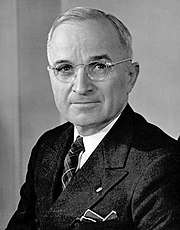James F. Byrnes
James Francis Byrnes (US: /ˈbɜːrnz/; May 2, 1882 – April 9, 1972) was an American judge and politician from the state of South Carolina. A member of the Democratic Party, Byrnes served in Congress, the executive branch, and on the United States Supreme Court. He was also the 104th Governor of South Carolina, making him one of the very few politicians to serve in all three branches of the American federal government while also being active in state government.
James F. Byrnes | |
|---|---|
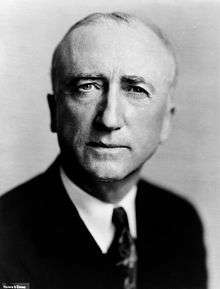 | |
| 104th Governor of South Carolina | |
| In office January 16, 1951 – January 18, 1955 | |
| Lieutenant | George Timmerman |
| Preceded by | Strom Thurmond |
| Succeeded by | George Timmerman |
| 49th United States Secretary of State | |
| In office July 3, 1945 – January 21, 1947 | |
| President | Harry S. Truman |
| Preceded by | Edward Stettinius Jr. |
| Succeeded by | George Marshall |
| Director of the Office of War Mobilization | |
| In office May 27, 1943 – July 3, 1945 | |
| President | Franklin D. Roosevelt |
| Preceded by | Position established |
| Succeeded by | John Snyder |
| Director of the Office of Economic Stabilization | |
| In office October 3, 1942 – May 27, 1943 | |
| President | Franklin D. Roosevelt |
| Preceded by | Position established |
| Succeeded by | Fred M. Vinson |
| Associate Justice of the Supreme Court of the United States | |
| In office June 25, 1941 – October 3, 1942[1] | |
| Nominated by | Franklin D. Roosevelt |
| Preceded by | James McReynolds |
| Succeeded by | Wiley Rutledge |
| United States Senator from South Carolina | |
| In office March 4, 1931 – July 8, 1941 | |
| Preceded by | Coleman Blease |
| Succeeded by | Alva M. Lumpkin |
| Member of the U.S. House of Representatives from South Carolina's 2nd district | |
| In office March 4, 1911 – March 3, 1925 | |
| Preceded by | James Patterson |
| Succeeded by | Butler Hare |
| Personal details | |
| Born | James Francis Byrnes May 2, 1882 Charleston, South Carolina, U.S. |
| Died | April 9, 1972 (aged 89) Columbia, South Carolina, U.S. |
| Political party | Democratic |
| Spouse(s) | Maude Busch (m. 1906) |
Born and raised in Charleston, South Carolina, Byrnes pursued a legal career with the help of his cousin, Governor Miles Benjamin McSweeney. Byrnes won election to the United States House of Representatives and served from 1911 to 1925. He became a close ally of US President Woodrow Wilson and a protégé of Senator Benjamin Tillman. He sought election to the US Senate in 1924, but narrowly lost a runoff election to Coleman Livingston Blease, who had the backing of the Ku Klux Klan. Byrnes then moved his law practice to Spartanburg, South Carolina and prepared for a political comeback. He narrowly defeated Blease in the 1930 Democratic primary and joined the Senate in 1931.
Historian George E. Mowry called Byrnes "the most influential Southern member of Congress between John Calhoun and Lyndon Johnson."[2] In the Senate, Byrnes supported the policies of his longtime friend, President Franklin Roosevelt. Byrnes championed the New Deal and sought federal investment in South Carolina water projects. He also supported Roosevelt's foreign policy, calling for a hard line against Imperial Japan and Nazi Germany. On the other hand, Byrnes opposed anti-lynching legislation and some of the labor laws proposed by Roosevelt, such as the Fair Labor Standards Act, which established a minimum wage. Roosevelt appointed Byrnes to the Supreme Court in 1941 but asked him to join the executive branch after the start of the Second World War. During the war, Byrnes led the Office of Economic Stabilization and the Office of War Mobilization and was a candidate to replace Henry A. Wallace as Roosevelt's running mate in the 1944 election, but instead, Harry S. Truman was nominated by the 1944 Democratic National Convention.
After Roosevelt's death, Byrnes served as a close adviser to Truman and became US Secretary of State in July 1945. In that capacity, Byrnes attended the Potsdam Conference and the Paris Conference. However, relations between Byrnes and Truman soured, and Byrnes resigned from the Cabinet in January 1947. He returned to elective politics in 1950 by winning election as the Governor of South Carolina.
As governor, he opposed the Supreme Court decision in Brown v. Board of Education and sought to establish "separate but equal" as a realistic alternative to the desegregation of schools. He endorsed most Republican presidential nominees after 1948 and supported Strom Thurmond's switch to the Republican Party in 1964.
Early life and career
He was born at 538 King St., in Charleston, South Carolina[3] and was reared in Charleston. Byrnes's father, James Francis Byrnes,[4] died shortly after Byrnes was born. His mother, Elizabeth McSweeney Byrnes, was an Irish-American dressmaker. In the 1880s, a widowed aunt and her three children came to live with them; one of the children was Frank J. Hogan, who went on to become president of the American Bar Association.[5] At 14, Byrnes left St. Patrick's Catholic School to work in a law office and became a court stenographer. Notably, he transcribed the murder trial of Lieutenant Governor of South Carolina, James H. Tillman, nephew of Benjamin Tillman, for the killing of Narciso Gener Gonzales, the newspaper editor of The Statetate.[6] In 1906, he married the former Maude Perkins Busch of Aiken, South Carolina. Though they had no children, he was the godparent of James Christopher Connor. Byrnes then converted from the Catholic Church to Episcopalianism.
In 1900, when Byrnes's cousin Governor Miles B. McSweeney appointed him as a clerk for Judge Robert Aldrich of Aiken, he needed to be 21. Byrnes, his mother, and McSweeney just changed his date of birth to that of his older sister,t tt Leonora.[7] He later apprenticed to a lawyer, then a common practice, read for the law and was admitted to the bar in 1903. In 1908, he was appointed solicitor for the second circuit of South Carolina and served until 1910.[8] Byrnes was a protégé of Benjamin Tillman, known as "Pitchfork Ben," and often had a moderating influence on the fiery segregationist senator.
In 1910, he narrowly won the South Carolina's 2nd congressional district in the Democratic primary, which was then tantamount to election. Byrnes proved a brilliant legislator, working behind the scenes to form coalitions and avoiding the high-profile oratory that characterized much of Southern politics. He was a champion of the "good roads" movement that attracted motorists and politicians, to large-scale road building programs in the 1920s. He became a close ally of US President Woodrow Wilson, who often entrusted important political tasks to the capable young representative, rather than to more experienced lawmakers.
United States Senate and Supreme Court
In 1924, Byrnes declined renomination to the House and instead sought nomination for the Senate seat held by incumbent Nathaniel B. Dial though both were former allies of the now-deceased "Pitchfork Ben" Tillman. Anti-Tillmanite and extreme racist demagogue Coleman Blease, who had challenged Dial in 1918, also ran again. Blease led the primary with 42 percent. Byrnes was second with 34 percent. Dial finished third with 22 percent.[9]
Byrnes was opposed by the Ku Klux Klan, which preferred Blease. Byrnes had been raised as a Roman Catholic, and the Klan spread rumors that he was still a secret Catholic. Byrnes countered by citing his support by Episcopalian clergy. Three days before the run-off vote, 20 Catholics who said that they had been altar boys with Byrnes published a professed endorsement of him. That group's leader was a Blease ally, and the "endorsement" was circulated in anti-Catholic areas.[10] Blease won the runoff 51% to 49%.[9]
After his House term ended in 1925, Byrnes was out of office. He moved his law practice to Spartanburg, in the industrializing Piedmont region. Between his law practice and investment advice from friends such as Bernard Baruch, Byrnes became a wealthy man, but he never excluded himself from a return to politics. He cultivated the Piedmont textile workers, who were key Blease supporters. In 1930, he challenged Blease again. Blease again led the primary, with 46 percent to 38 percent for Byrnes, but this time, Byrnes won the runoff 51 to 49 percent.[11]
During his time in the Senate, Byrnes was regarded as the most influential South Carolinian since John C. Calhoun.[12] He had long been friends with Franklin Roosevelt, whom he supported for the Democratic nomination in 1932, and made himself Roosevelt's spokesman on the Senate floor, where he guided much of the early New Deal legislation to passage. He won an easy re-election in 1936, promising:
I admit I am a New Dealer, and if [the New Deal] takes money from the few who have controlled the country and gives it back to the average man, I am going to Washington to help the President work for the people of South Carolina and the country.
Since the colonial era, South Carolina's politicians had dreamed of an inland waterway system that would not only aid commerce but also control flooding. By the 1930s, Byrnes took up the cause for a massive dam-building project, Santee Cooper, that would not only accomplish those tasks but also electrify the entire state with hydroelectric power. With South Carolina financially strapped by the Great Depression, Byrnes managed to get the federal government to authorize a loan for the entire project, which was completed and put into operation in February 1942. The loan was later paid back to the federal government with full interest and at no cost to South Carolina taxpayers. Santee Cooper has continued to be a model for public-owned electrical utilities worldwide.
In 1937, Byrnes supported Roosevelt on the highly-controversial court packing plan, but he voted against the 1938 Fair Labor Standards Act, a minimum wage as potentially making the textile mills in his state uncompetitive. He opposed Roosevelt's efforts to purge conservative Democrats in the 1938 primary elections. On foreign policy, Byrnes was a champion of Roosevelt's positions of helping the United Kingdom and France against Nazi Germany in 1939 to 1941 and of maintaining a hard diplomatic line against Japan.
Byrnes played a key role in blocking anti-lynching legislation, notably the Castigan-Wagner bill of 1935 and the Gavagan bill of 1937.[13] Byrnes even claimed that lynching was necessary "in order to hold in check the Negro in the south" and said that "rape is responsible, directly and indirectly, for most of the lynching in America."[14]
Byrnes despised his fellow South Carolina Senator "Cotton Ed" Smith, who strongly opposed the New Deal.[15] He privately sought to help his friend Burnet R. Maybank, then the mayor of Charleston, defeat Smith in the 1938 Senate primary. During the primary, however, Olin Johnston, who was limited to one term as governor, decided to run for the Senate. Because Johnston was also a pro-Roosevelt New Dealer,[15] he would have divided the New Deal vote with Maybank and ensured a victory for Smith. Johnston was also supportive of the New Deal's labor legislation,[16] but Byrnes's support was limited,[16] and a series of labor strikes in the fall of 1937 made Byrnes withdraw consideration for potentially endorsing Johnston.[17] Taking advice from Byrnes, Maybank decided to run for governor instead, and Byrnes made the reluctant decision to support Smith.[18] Byrnes envisioned that Smith would retire in 1944 and that Maybank would successfully run for Smith's Senate seat and build a strong political machine in the state with him.[18]
In part as a reward for his crucial support on many issues, Roosevelt appointed Byrnes an Associate Justice of the US Supreme Court in July 1941, the second-last justice appointed to the Supreme Court who had been admitted to practice by reading law and the last who had never attended law school. Byrnes resigned from the Court after only 15 months to head the Office of Economic Stabilization. His Supreme Court tenure is the second shortest of any justice.[19][8]
World War II
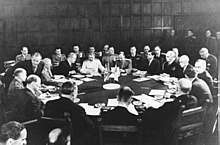
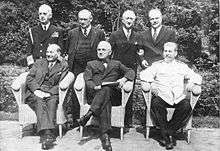
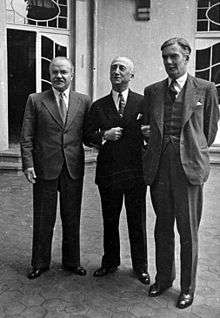
Byrnes left the Supreme Court to head Roosevelt's Office of Economic Stabilization, which dealt with the vitally-important issues of prices and taxes.[8] How powerful the new office would become depended entirely on Byrnes's political skills, and Washington insiders soon reported that he was fully in charge. In May 1943, he became head of the Office of War Mobilization, a new agency that supervised the Office of Economic Stabilization.[20] Under the leadership of Byrnes, the program managed newly-constructed factories across the country that used raw materials, civilian and military production, and transportation for US military personnel and was credited with providing the employment that was needed to bring an official end to the Great Depression.[21][22][23] Thanks to his political experience, his probing intellect, his close friendship with Roosevelt, and in no small par his own personal charm, Byrnes was soon exerting influence over many facets of the war effort that were not technically under his departmental jurisdiction. Many in Congress and the press began referring to Byrnes as the "Assistant President."[24][25]
Many expected that Byrnes would be the Democratic nominee in 1944 for vice president with Roosevelt,[26] replacing Henry A. Wallace, who was strongly felt by party officials strongly felt to be too eccentric to replace an ailing president who would likely die before his next term ended.[27] Roosevelt refused to endorse anybody other than Wallace. He had a personal preference for US Supreme Court justice William O. Douglas. Byrnes was on Roosevelt's list but was hardly his first choice. In a July meeting at the White House, the party bosses pressed hard for Senator Harry S. Truman of Missouri, and Roosevelt issued a statement saying he would support either Truman or Douglas. Byrnes was regarded as too conservative for organized labor, the big city bosses opposed him as an ex-Catholic who would offend Catholics, and blacks were wary of his opposition to racial integration.[28] In short, Byrnes never had a serious chance at being nominated for vice-president, and the nomination went instead to Truman. Roosevelt brought Byrnes to the Yalta Conference in early 1945 in which he seemed to favor Soviet plans. Written in shorthand, his notes comprise one of the most complete records of the "Big Three" Yalta meetings.
Secretary of State
Upon his succession to the presidency after Roosevelt's death, on April 12, 1945, Truman relied heavily on Byrnes's counsel, Byrnes having been a mentor to Truman from the latter's earliest days in the Senate.[29][30] Indeed, Byrnes was one of the first people seen by Truman on the first day of his presidency.[31] It was Byrnes who shared information with the new president on the atomic bomb project (until then, Truman had known nothing about the Manhattan Project).[32] When Truman met Roosevelt's coffin in Washington, he asked Byrnes and former Vice President Wallace, the two other men who might well have succeeded Roosevelt, to join him at the train station.[33] Truman originally intended for both men to play leading roles in his administration to signal continuity with Roosevelt's policies. Truman quickly fell out with Wallace but retained a good working relationship with Byrnes and increasingly turned to him for support.[34]
Truman appointed Byrnes as US Secretary of State on July 3, 1945.[35] As Secretary of State, he was first in line to the Presidency since there was no Vice-President during Truman's first term. He played a major role at the Potsdam Conference, the Paris Peace Conference, and other major postwar conferences. According to historian Robert Hugh Ferrell, Byrnes knew little more about foreign relations than Truman. He made decisions after consulting a few advisors, such as Donald S. Russell and Benjamin V. Cohen. Byrnes and his small group paid little attention to the State Department experts and similarly ignored Truman.[36]

Because Byrnes had been part of the US delegation at Yalta, Truman assumed that he had accurate knowledge of what had transpired. It would be many months before Truman discovered that not to be the case. Nevertheless, Byrnes advised that the Soviets were breaking the Yalta Agreement and that Truman needed to be resolute and uncompromising with them. [37]
Truman was rapidly moving toward a hardline position on Soviet intentions in Eastern Europe and Iran, but Byrnes was much more conciliatory. The distance between them grew and ties of personal friendship weakened. In late 1945, Byrnes argued with Soviet Foreign Minister Viacheslav Molotov over Soviet pressures on Bulgaria and Romania. Byrnes sent Mark Ethridge, a liberal journalist, to investigate; Ethridge found conditions were indeed bad. Ethridge wrote a damning report, but Byrnes ignored it and instead endorsed a Soviet offer. Truman read Ethridge's report and decided that Byrnes's softline approach was a failure and that the US needed to stand up to the Kremlin.[38]
Personal relations between the two men grew strained, particularly when Truman felt that Byrnes was attempting to set foreign policy by himself and to inform the President only afterward. An early instance of the friction was the Moscow Conference in December 1945. Truman considered the "successes" of the conference to be "unreal" and was highly critical of Byrnes's failure to protect Iran, which was not mentioned in the final communiqué. "I had been left in the dark about the Moscow conference," Truman told Byrnes bluntly.[39] In a subsequent letter to Byrnes, Truman took a harder line in reference to Iran: "Without these supplies furnished by the United States, Russia would have been ignominiously defeated. Yet now Russia stirs up rebellion and keeps troops on the soil of her friend and ally— Iran. .. Unless Russia is faced with an iron fist and strong language another war is in the making. Only one language do they understand.... I do not think we should play compromise any longer.... I am tired of babying the Soviets".[40] That led to the Iran crisis of 1946 in which Byrnes took an increasingly hardline position in opposition to Stalin, culminating in a speech in Germany on September 6, 1946. The "Restatement of Policy on Germany," also known as the "Speech of Hope", set the tone of future US policy vt repudiating the Morgenthau Plan, an economic program that would permanently deindustrialize Germany. Byrnes was named TIME Man of the Year. Truman and others believed that Byrnes had grown resentful that he had not been Roosevelt's running mate and successor and so was disrespecting Truman. Whether or not that was true, Byrnes felt compelled to resign from the Cabinet in 1947 with some feelings of bitterness.
Governor of South Carolina
At an age in which most of his contemporaries retired from politics, Byrnes was not yet ready to give up public service. At 68, he was elected governor of South Carolina and served from 1951 to 1955. Supporting segregation in education, the Democratic governor stated in his inaugural address:
Whatever is necessary to continue the separation of the races in the schools of South Carolina is going to be done by the white people of the state. That is my ticket as a private citizen. It will be my ticket as governor.
— James F. Byrnes[41]
Ironically, Byrnes was initially seen as a relative moderate on race issues. Recognizing that the South could not continue with its entrenched segregationist policies much longer but fearing that Congress would impose sweeping change upon the South, he opted for a course of change from within. To that end, he sought to fulfill at last the "separate but equal" policy that the South had put forward in Supreme Court civil rights cases, particularly in regard to public education. Byrnes poured state money into improving black schools, buying new textbooks and new buses, and hiring additional teachers. He also sought to curb the power of the Ku Klux Klan by passing a law that prohibited adults from wearing a mask in public on any day other than Halloween; he knew that many Klansmen feared exposure and would not appear in public in their robes unless their faces were hidden as well. Byrnes hoped to make South Carolina an example for other Southern states to follow in modifying their "Jim Crow" policies. Nonetheless, the NAACP sued South Carolina to force the state to desegregate its schools. Byrnes requested Kansas, a Midwestern state that also segregated its schools, to provide an amicus curiae brief in supporting the right of a state to segregate its schools. That gave the NAACP's lawyer, Thurgood Marshall, the idea to shift the suit from South Carolina over to Kansas, which led directly to Brown v. Board of Education, a decision that Byrnes vigorously criticized.
The South Carolina Constitution then barred governors from immediate re-election and so Byrnes retired from active political life after the 1954 election.
Later political career
In his later years, Byrnes foresaw that the American South could play a more important role in national politics. To hasten that development, he sought to end the region's nearly-automatic support of the Democratic Party, which Byrnes believed had grown too liberal and took the "Solid South" for granted at election time but otherwise ignored the region and its needs.
Byrnes endorsed Dwight Eisenhower in 1952, segregationist candidate Harry Byrd in 1956, Richard Nixon in 1960 and 1968, and Barry Goldwater in 1964.[42] He gave his private blessing to US Senator Strom Thurmond of South Carolina to bolt the Democratic Party in 1964 and to declare himself a Republican, but Byrnes still himself remained a Democrat.
In 1965, Byrnes spoke out against the "punishment" and the "humiliation" of South Carolina US Representative Albert Watson, who had been stripped of his congressional seniority by the House Democratic Caucus after endorsing Goldwater for president. Byrnes openly endorsed Watson's retention in Congress as a Republican in a special election held in 1965 against Democrat Preston Callison. Watson secured $20,000 and the services of a Republican field representative in what he termed "quite a contrast" to his treatment from Democratic House colleagues.[43][44]
Following Byrnes's death at the age of 89, he was interred in the churchyard at Trinity Episcopal Church in Columbia, South Carolina.
Legacy
Byrnes is memorialized at several South Carolina universities and schools:
- The James F. Byrnes Building, housing the Byrnes International Center at the University of South Carolina.
- The James F. Byrnes Professorship of International Studies at USC, its first endowed professorship.
- Byrnes Auditorium at Winthrop University.
- Byrnes Hall, a dormitory at Clemson University, where Byrnes was a Life Trustee.
- James F. Byrnes High School in Duncan, South Carolina.
- The Byrnes Schools (formerly the James F. Byrnes Academy) in Quinby, South Carolina.
In 1948, Byrnes and his wife established the James F. Byrnes Foundation Scholarships, and since then, more than 1,000 young South Carolinians have been assisted in obtaining a college education. His papers are in Clemson University's Special Collections Library.
Electoral history
See also
- Demographics of the Supreme Court of the United States
- List of Justices of the Supreme Court of the United States by court composition
- List of Justices of the Supreme Court of the United States by education
- List of Justices of the Supreme Court of the United States by time in office
- List of law clerks of the Supreme Court of the United States
- List of United States Chief Justices by time in office
- United States Supreme Court cases during the Stone Court
- Oliver Stone's Untold History of the United States, Episodes 2 and 3
Footnotes
- "Timeline of the Court - James F. Byrnes". Supreme Court Historical Society. Retrieved July 10, 2012.
- David Robertson, Sly and Able: A Political Biography of James F. Byrnes (1994) p. 126
- "Do You Know Your Charleston?". Charleston News & Courier. p. 8. Retrieved September 16, 2012.
- "Governor of the State of South Carolina - James Francis Byrnes, Jr".
- Ransom, William L. (1944). "Frank J. Hogan, 1877-1944". ABA Journal. 30 (7): 393–395. JSTOR 25714990.
- James L. Underwood (December 15, 2013). Deadly Censorship. The University of South Carolina Press. p. Note 4. ISBN 9781611173000. Retrieved February 11, 2016.
- "SC Governors - James Francis Byrnes, 1951 - 1955". SCIWAY. Retrieved July 10, 2012.
- "BYRNES, James Francis". Biographical Directory of the U.S. Congress. Office of the Clerk. Retrieved January 9, 2012.
- "Report of the Secretary of State to the General Assembly of South Carolina. Part II." Reports of State Officers Boards and Committees to the General Assembly of the State of South Carolina. Volume I. Columbia, SC: 1925, p. 59.
- Pope, Thomas H. The History of Newberry County, South Carolina: 1860–1990. p. 110
- "Supplemental Report of the Secretary of State to the General Assembly of South Carolina." Reports of State Officers Boards and Committees to the General Assembly of the State of South Carolina. Volume I. Columbia, SC: 1931, p. 3.
- Lee, Joseph Edward (April 1995). "Book Reviews and Notes - Sly and Able: A Political Biography of James F. Byrnes". South Carolina Historical Magazine. South Carolina Historical Society. 96 (2): 174–176. JSTOR 27570082.
- Walter Francis White#Anti-Lynching Legislation
- Sean Dennis Cashman (January 1, 1989). America in the Twenties and Thirties: The Olympian Age of Franklin Delano Roosevelt. NYU Press. pp. 271–. ISBN 978-0-8147-7208-9.
- "ELECTIONS: Curtains for Cotton Ed". Time. August 7, 1944.
- Storrs, Landon R. Y. (2000). Civilizing Capitalism: The National Consumers' League, Women's Activism, and Labor Standards in the New Deal Era. Univ of North Carolina Press. ISBN 9780807848388. Retrieved July 10, 2012.
- Simon, Bryant. A fabric of defeat: the politics of South Carolina millhands, 1910–1948, p. 208-210
- Simon, Bryant. A fabric of defeat: the politics of South Carolina millhands, 1910–1948, p. 212
- "Frequently Asked Questions on Justices - Supreme Court of the United States".
- Wallace, David Duncan. South Carolina: A Short History (University of North Carolina Press: Chapel Hill, 1951) p. 677.
- "| Economic History Services". Eh.net. Archived from the original on July 18, 2012. Retrieved September 6, 2012.
- Research & Articles on Economy, World War II by. BookRags.com. Retrieved September 6, 2012.
- "Economy in World War II: Home Front". Shmoop.com. Retrieved September 6, 2012.
- Ibid.
- Herman, Arthur. Freedom's Forge: How American Business Produced Victory in World War II, pp. 189-90, 247, 330, Random House, New York, NY. ISBN 978-1-4000-6964-4.
- Ibid.
- LeRoy Ashby (September 2, 2012). "American Dreamer: The life and times of Henry A. Wallace". The Journal of American History. Jah.oxfordjournals.org. 88 (4): 1586. doi:10.2307/2700719. JSTOR 2700719. Retrieved September 6, 2012.
- Ibid.
- Messer, Robert L. 'The End of an Alliance: James F. Byrnes, Roosevelt, Truman, and the Origins of the Cold War (Chapel Hill: University of North Carolina Press, 1982), 13. Cited in reliance on citation in Robert J. Lifton and Greg Mitchell, Hiroshima in America, Fifty Years of Denial (G. P. Putnam's Sons, 1995), 136 (footnote, Byrnes "as a kindly 'older brother' to Truman" in the Senate).
- Gar Alperovitz, "The Decision to Use the Atomic Bomb" (New York: Vintage Books, 1996)
- David McCullough, Truman (Simon & Schuster:New York, 1992)p. 352.
- Ibid
- Ibid.
- Ibid. p. 388.
- "A revealing moment during Byrnes' swearing-in ceremony as secretary of state offers insight into the relationship [between President Harry S. Truman and Byrnes]: The diary of Byrnes' friend and assistant Walter Brown records that 'when the oath was completed, the President said, "Jimmy, kiss the Bible." He did and then handed it over to the President and told him to kiss it, too. The President did so as the crowd laughed l ..." Gar Alperovitz, The Decision to Use the Atomic Bomb and the Architecture of an American Myth (New York: Alfred A. Knopf, 1995, p. 197).
- Robert H. Ferrell (1994). Harry S. Truman: A Life. University of Missouri Press. pp. 236–237. ISBN 978-0-8262-6045-1.
- Harry S. Truman (1980). Ferrell, Robert H. (ed.). Off the Record: The Private Papers of Harry S. Truman. Harper & Row. p. 17. ISBN 978-0-8262-1119-4.
- David R. Stone, "The 1945 Ethridge Mission to Bulgaria and Romania and the origins of the Cold War in the Balkans." Diplomacy and Statecraft 17.1 (2006): 93-112.
- Harry S. Truman, Memoirs, Vol. 1: Years of Decision (1955), p.547, 550, cited in George Lenczowski, American Presidents and the Middle East, p.10
- Truman, Memoirs, Vol. 1: Years of Decision (1955), p.551–552, cited in Lenczowski, American Presidents, p.11
- Bruce Bartlett (January 8, 2008). Wrong on Race: The Democratic Party's Buried Past. St. Martin's Press. pp. 51–. ISBN 978-0-230-61138-2.
- Lamis, Alexander (1988). The Two-Party South. New York: Oxford University Press. pp. 15–16.
- Billy Hathorn, "The Changing Politics of Race: Congressman Albert William Watson and the South Carolina Republican Party, 1965-1970", South Carolina Historical Magazine Vol. 89 (October 1988), p. 230
- Congressional Quarterly Weekly Report, Vol. 23 (June 18, 1965), p. 1185; Bernard Cosman and Robert J. Huckshorn, eds., Republican Politics: The 1964 Campaign and Its Aftermath for the Party (New York: Praeger, 1968), pp. 147–148
References
- Messer, Robert L. The End of an Alliance: James F. Byrnes, Roosevelt, Truman, and the Origins of the Cold War (1982).
- Robertson, David. Sly and Able: A Political Biography of James F. Byrnes (1994)
- Annotated bibliography for James Byrnes from the Alsos Digital Library for Nuclear Issues
- James Francis Byrnes at the Biographical Directory of Federal Judges, a public domain publication of the Federal Judicial Center.
Primary sources
- Byrnes, James. Speaking Frankly (1947)
- Byrnes, James. All in One Lifetime (1958).
Further reading
- Abraham, Henry J., Justices and Presidents: A Political History of Appointments to the Supreme Court. 3d. ed. (New York: Oxford University Press, 1992). ISBN 0-19-506557-3.
- Anderson, David L. "Byrnes, James Francis (02 May 1882–09 April 1972), U.S. senator and secretary of state" American National Biography (1999)
- Burns, Richard. "James Byrnes." in Norman A. Graebner, ed. An Uncertain Tradition: American Secretaries of State in the Twentieth Century (1961). pp 223-44.
- Clements, Kendrick A., ed., James F. Byrnes and the Origins of the Cold War (1982)
- Cushman, Clare, The Supreme Court Justices: Illustrated Biographies, 1789–1995 (2nd ed.) (Supreme Court Historical Society), (Congressional Quarterly Books, 2001) ISBN 1-56802-126-7; ISBN 978-1-56802-126-3.
- Hopkins, Michael F. "President Harry Truman's Secretaries of State: Stettinius, Byrnes, Marshall and Acheson." Journal of Transatlantic Studies 6.3 (2008): 290-304.
- Messer, Robert L. The End of an Alliance: James F. Byrnes, Roosevelt, Truman, and the Origins of the Cold War (1982)
- Robertson, David. Sly and Able: A Political Biography of James F. Byrnes (1994)
- Ward, Patricia Dawson. The Threat of Peace: James F. Byrnes and the Council of Foreign Ministers, 1945–1946 (1979)
External links
| Wikimedia Commons has media related to James Francis Byrnes. |
- Excerpts from Speaking Frankly on the subjects of: (Yalta Conference), (Potsdam Conference) ("Flash Player" is required)
- James Francis Byrnes and U.S. Policy towards Germany 1945–1947 Deutsch-Amerikanische Zentrum / James-F.-Byrnes-Institut e.V
- Text of the famous "Stuttgart speech", September 6, 1946 The speech marked the change in U.S. occupation policy in Germany towards reconstruction.
- Time Magazine, September 16, 1946. "Journey to Stuttgart"
- SCIway Biography of James Francis Byrnes
- NGA Biography of James Francis Byrnes
- James F. Byrnes at Find a Grave
- A film clip Byrnes Sets U.S. Policy for Germany, 1946/09/10 (1946) is available at the Internet Archive
- A film clip Byrnes Wants All To Share Peacemaking, 1946/10/17 (1946) is available at the Internet Archive
- A film clip Byrnes Denies Atom Threat, 1946/10/10 (1946) is available at the Internet Archive
- Annotated bibliography from the Alsos Digital Library for Nuclear Issues
- James F. Byrnes Papers at Clemson University Special Collections Library
- A collection of various works by James F. Byrnes
- Newspaper clippings about James F. Byrnes in the 20th Century Press Archives of the ZBW
| U.S. House of Representatives | ||
|---|---|---|
| Preceded by James Patterson |
Member of the U.S. House of Representatives from South Carolina's 2nd congressional district 1911–1925 |
Succeeded by Butler Hare |
| Party political offices | ||
| Preceded by Coleman Blease |
Democratic nominee for U.S. Senator from South Carolina (Class 2) 1930, 1936 |
Succeeded by Burnet Maybank |
| Preceded by Strom Thurmond |
Democratic nominee for Governor of South Carolina 1950 |
Succeeded by George Timmerman |
| U.S. Senate | ||
| Preceded by Coleman Blease |
U.S. Senator (Class 2) from South Carolina 1931–1941 Served alongside: Ed Smith |
Succeeded by Alva Lumpkin |
| Preceded by John Townsend |
Chair of the Senate Contingent Expenses Audit Committee 1933–1941 |
Succeeded by Scott Lucas |
| Legal offices | ||
| Preceded by James McReynolds |
Associate Justice of the Supreme Court of the United States 1941–1942 |
Succeeded by Wiley Rutledge |
| Political offices | ||
| New office | Director of the Office of Economic Stabilization 1942–1943 |
Succeeded by Fred Vinson |
| Director of the Office of War Mobilization 1943–1945 |
Succeeded by John Snyder | |
| Preceded by Edward Stettinius |
United States Secretary of State 1945–1947 |
Succeeded by George Marshall |
| Preceded by Strom Thurmond |
Governor of South Carolina 1951–1955 |
Succeeded by George Timmerman |


